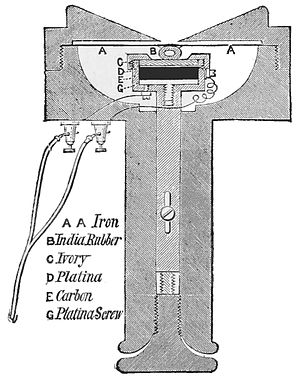Though all these processes tend to impair the delicacy of the button, it is still far superior to a button made of any other substance.
The first application made of the carbon button was in the telephone. The arrangement of the apparatus is shown in Fig. 4. The carbon button, E, is placed between two platinum plates, D and G, which are in the circuit of a battery, as shown by the figure. Upon the upper platinum, D, is placed an ivory plate, C. A piece of rubber

Fig. 4.
tubing, B, connects the ivory with the vibrating diaphragm, A A. All this is inclosed in a hard-rubber case with suitable mouthpiece and adjusting apparatus. The vibrations of the diaphragm communicated through the rubber cause variations in the pressure upon the carbon, and corresponding variations in the strength of the current which traverses the wire. At the receiving station an instrument similar to the one already described, invented by Gray, may be used.
At first the diaphragm was made so delicate that it continued to vibrate an appreciable time after the cause which set it in vibration ceased to act, at least long enough to cause an interference in articulation due to the mingling of successive vibrations. The object of the piece of rubber was to dampen the vibrations of the diaphragm, or to bring the diaphragm quickly to rest after it has been set in motion by a sound. The rubber was found to be somewhat tardy in its action; at best the sound emitted was muffled. The rubber had the additional disadvantage of becoming somewhat flattened with use, thus necessitating readjustment. Experiments were then made to find something which would bring the diaphragm to rest more quickly than the rubber could, and for that purpose a thin spiral metallic spring was sub-

